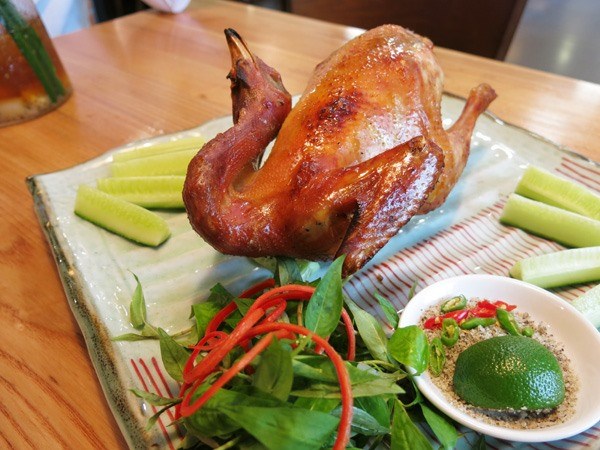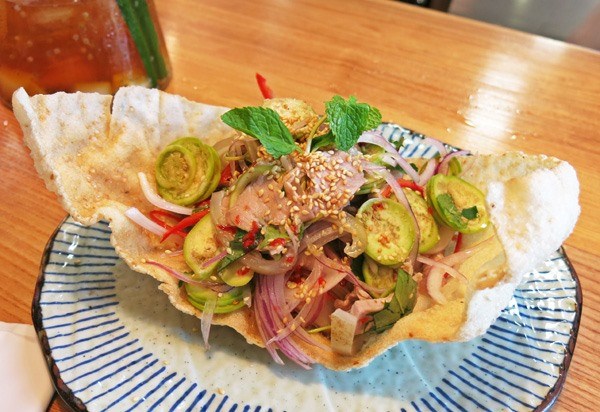Ca phao – garden egg – is as important to Vietnamese as kim chi is to Koreans. It is a type of fruit that is often salted and served as a side dish in Vietnamese meals.
Every
Vietnamese knows the words to this folk ditty: From this far-off place I long for my hometown//for a bowl of morning
glory soup//a cup of garden eggs//macerated in soybean paste.

Golden skin: A chicken grilled in clay pot, served with rau ram (laksa leaves) and cucumbers at Mon Ngon Sai Thanh Restaurant in Ha Noi. — VNS Photo Bao Hoa
It
depicts a typical Vietnamese meal back in the poor old days when we were
lacking all sorts of necessities. No meat, no fish, not even eggs – just
vegetables and rice.
Salted
garden egg adds flavour to the rather bland taste caused by the lack of protein
in such simple meals. Its salty taste seems to sweeten the rau muong (morning glory) or rau
mong toi (malabar spinach) soup, and its crunchy texture makes each chew
more enjoyable.
Dozens
of variations of the garden egg dish have been created over the years. Goi ca phao thit be (garden egg salad
with veal) is one of those spin-off dishes that I found rather impressive.
If
garden eggs and veal are the main ingredients of the dish, the sweet-and-sour
sauce is the star.
The
fruits and meat are cut into thin slices, mixed together with the sauce and
strongly-flavoured herbs of lemongrass, fish mint, mint, pepper, red chili and
garlic. The mixture is then placed in a crispy thin slice of banh trang me (sesame rice cracker) and
served as an appetizer.

Multicoloured feast: Goi ca phao thit be (garden egg salad with veal) dish at Mon Ngon Sai Thanh Restaurant in Ha Noi. — VNS Photo Bao Hoa
Take
a small piece of sesame rice cracker, use chopsticks to pick up a portion of salad,
place it on your piece of cracker then enjoy the whole piece together. Reaching
a fine combination of sweetness and sourness that is neither too little nor too
much, the sweet-and-sour sauce heightens the flavours of other ingredients and
leaves a pleasant sweet aftertaste on your tongue.
As
you chew, the soft slice of veal, crunchy slice of garden egg and crispy piece
of sesame rice cracker preserve the sweet and sour flavours in your mouth for a
little longer after you swallow the herbs. The fresh odors of lemongrass and
mint balance the sweetness – but be cautious with fish mint: its smell is a
delight for some people but fishy for others.
Chicken grilled in
clay pots
Recently
at the newly-opened Mon Ngon Sai Thanh Restaurant, located at No 59A on the
capital city’s Huynh Thuc Khang Street, I was served the salad as an appetizer,
followed by a ga nuong lu (chicken
grilled in clay pot) entree. I found that the two dishes complement each other
well since I was expecting something a bit greasy after enjoying the light
salad.
The
technique of grilling chickens in big clay pots came from the southwestern
region of Viet Nam, according to culinary expert Le Kim Chi of the Quan An Ngon
Restaurant chain in Ha Noi.

The southwestern way: Chickens being grilled in a clay pot, with charcoal burning at the bottom of the pot. — Photo vivuhanoi.com
“Ovens
weren’t available in the old days, so the southwestern people took advantage of
the clay pots – an everyday item in every family – to cook their chickens,” she
said.
Chickens
will be stuffed with lemon leaves and green onions and seasoned on the outside
before being hung near the top of a clay pot. Charcoal will be put at the
bottom, and the pot will be covered well so that heat from the charcoal will
radiate evenly.
The
result is ideal, pinky moist on the inside, crunchy on the outside, an effect
that every cook aims to master.
“The
older southwestern generations would take a portion of rice and grilled chicken
to the paddy fields and have it at lunchtime,” Chi said.
“They
would put some banana leaves on the ground and have lunch right beside their
fields.”
“I
found [it] to be a very smart way of cooking chickens,” she added.
“It
doesn’t only make a tasty dish but has also become a distinctive feature of the
southwestern region.”
I
like to taste the chicken by itself to enjoy its natural sweetness, but a small
dish that contains a mixture of spices, and lemonade sprinkled with shredded
lemon leaves is always presented along with the chicken for those who want a
stronger taste.
Having
chicken with lemon leaves is another Vietnamese culinary tradition. The oil
essence in the leaves is said to cool the body after a hot meal.
By VNS